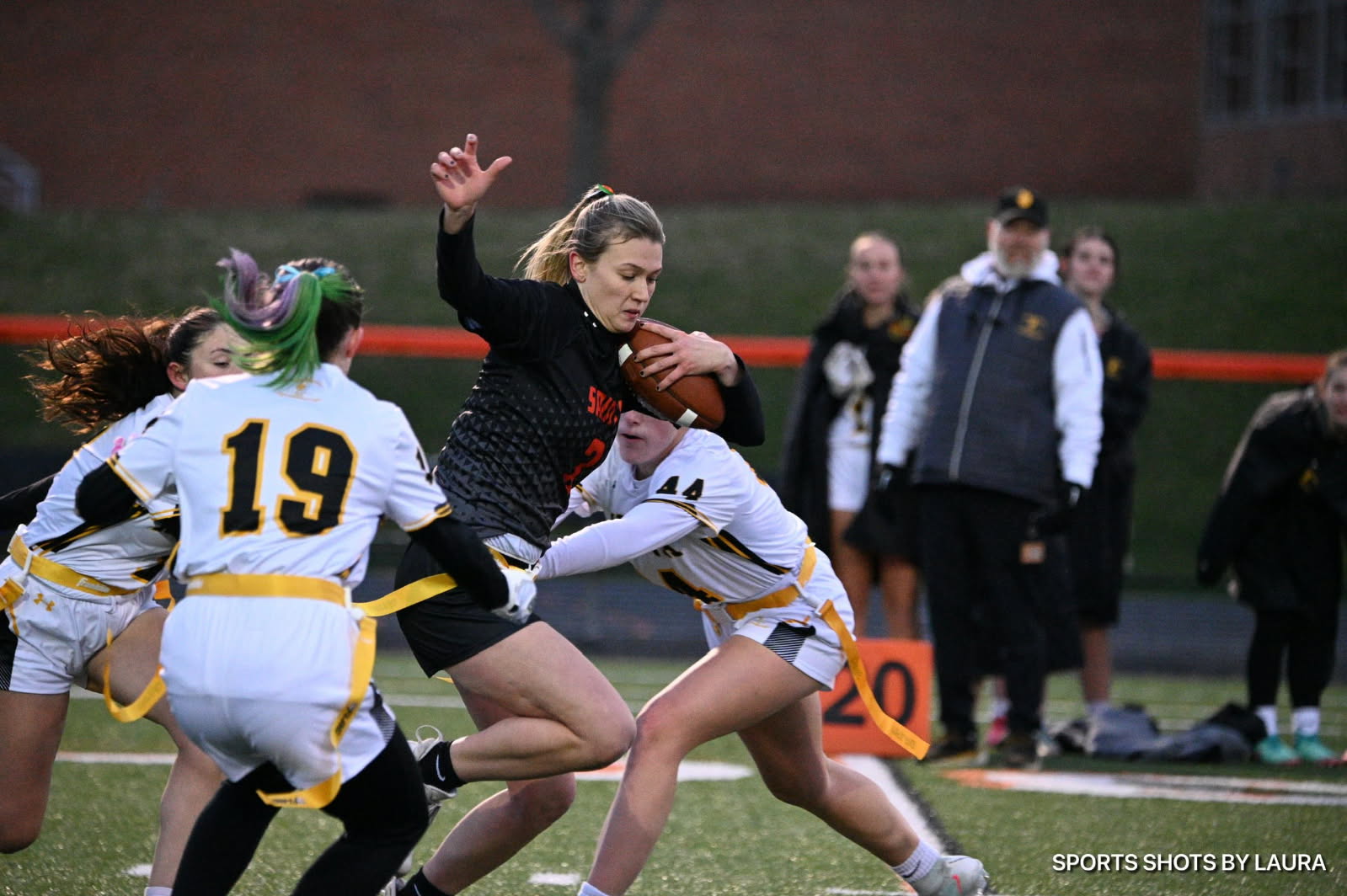Rec Sports
Monday Flag Football Wrap



Rec Sports
IOC advises sports bodies to let Russian youth teams, athletes compete again with flag and anthem

The IOC has taken a big step toward reintegrating Russia and Belarus into world sports. It’s advising governing bodies of Olympic sports to let youth teams and…
GENEVA(AP) — The IOC took a big step toward reintegrating Russia and Belarus into world sports Thursday by advising governing bodies to let the countries’ youth teams and athletes compete with their full identity of national flag and anthem.
Athletes have “a fundamental right to access sport across the world, and to compete free from political interference or pressure from governmental organizations,” the International Olympic Committee said in a statement.
That message in support of athletes will be welcomed in Russia and Israel, whose athletes have faced recent discrimination, and comes less than three years out from the 2028 Los Angeles Summer Games that risks facing political crosswinds in the United States.
The updated strategy on Russia was set at a so-called Olympic Summit — a meeting chaired by IOC president Kirsty Coventry that invites key stakeholders from the Olympic family.
“It was recognized that implementation by the stakeholders will take time,” the IOC said in a statement, adding that each sport’s governing body should decide how to define youth events.
Some sports bodies likely will face resistance from their national member federations, especially in Europe, to the updated IOC advice which repeats that Russia should still not be picked to host international events.
The IOC’s latest move to ease the sporting isolation of Russia can apply to its own Youth Olympic Games which are held next year in Dakar, Senegal, from Oct. 31 to Nov. 13. The Russian Olympic body is still formally suspended by the IOC and currently could not compete with its national identity.
“The above principles should apply to the Dakar 2026 Youth Olympic Games, and are recommended for adoption by all governing bodies and international sports event organizers for their own youth events,” the IOC said.
Russian teams have been fully excluded from international soccer, track and field and other sports since the full military invasion of Ukraine in February 2022, while Russian and Belarusian athletes in winter sports are now starting to return with neutral status ahead of the Milan Cortina Olympics in February.
A small group of Russian and Belarusian athletes competed as neutrals without their national identity at the Paris Summer Games last year, where those countries were banned from team sports.
A previous attempt to enable Russia’s potential return to youth sports was met with strong pushback by European soccer federations including Ukraine in September 2023.
European soccer body UEFA moved to reintegrate Russian Under-17 teams into its competitions but dropped its policy within weeks amid boycott threats by at least 12 of the 55 member federations.
AP Winter Olympics at https://apnews.com/hub/milan-cortina-2026-winter-olympics
Copyright 2025 Associated Press. All rights reserved. This material may not be published, broadcast, rewritten, or redistributed.
Rec Sports
IOC recommends Russian youths compete with flag, anthem

GENEVA — The International Olympic Committee took a big step toward reintegrating Russia and Belarus into world sports Thursday by advising governing bodies to let the countries’ youth teams and athletes compete with their full identity of national flag and anthem.
Athletes have “a fundamental right to access sport across the world, and to compete free from political interference or pressure from governmental organizations,” the IOC said in a statement.
That message in support of athletes will be welcomed in Russia and Israel, whose athletes have faced recent boycotts and discrimination, and comes less than three years out from the 2028 Los Angeles Summer Games that risks facing political crosswinds in the United States.
The updated strategy on Russia was set at a so-called Olympic Summit — a meeting chaired by IOC president Kirsty Coventry that invites key stakeholders from the Olympic family.
“It was recognized that implementation by the stakeholders will take time,” the IOC said in a statement, adding that each sport’s governing body should decide how to define youth events.
Some sports bodies likely will face resistance from their national member federations, especially in Europe, to the updated IOC advice reiterating that Russia should still not be picked to host international events.
The IOC’s latest move to ease the sporting isolation of Russia can apply to its own Youth Olympic Games which are held next year in Dakar, Senegal, from Oct. 31 to Nov. 13. The Russian Olympic body is still formally suspended by the IOC and currently could not compete with its national identity.
“The above principles should apply to the Dakar 2026 Youth Olympic Games, and are recommended for adoption by all governing bodies and international sports event organizers for their own youth events,” the IOC said.
Russian teams have been fully excluded from international soccer, track and field and other sports since the full military invasion of Ukraine in February 2022, while Russian and Belarusian athletes in winter sports are now starting to return with neutral status ahead of the Milan Cortina Olympics in February.
A small group of Russian and Belarusian athletes competed as neutrals without their national identity at the Paris Summer Games last year, where those countries were banned from team sports.
A previous attempt to enable Russia’s potential return to youth sports was met with strong pushback by European soccer federations including Ukraine in September 2023.
European soccer body UEFA moved to reintegrate Russian under-17 teams into its competitions but dropped its policy within weeks amid boycott threats by at least 12 of the 55 member federations.
Rec Sports
Daily Guardian – There are moments in sports when a win is…

There are moments in sports when a win is more than a number on a board — it becomes a quiet rebellion. That’s what the recent victories of our men’s and women’s football teams in the 2025 SEA Games felt like. Beating defending champions didn’t just shock pundits; it made many of us sit straighter and whisper the phrase we’ve whispered too often when Filipinos succeed against the odds — “Pwede pala.” These wins weren’t accidents born out of lucky kicks. They came from kids who learned the game barefoot, from parents who tucked muddy cleats in plastic bags, from small communities where dreams are louder than megaphones and politicians’ tarps. It came from faith — not the type that waits, but the type that builds, sweats, and hopes. That is why these wins must be seen as more than medals. They are reminders that football deserves serious and sustained investment, the same way we proudly support basketball and volleyball — and even the non-mainstream sports where we have a global fighting chance such as boxing, weightlifting, athletics, gymnastics, and even chess, where height is not a limitation and strategy, endurance, and heart bridge the gap talent alone cannot.
Rec Sports
Bring the Winter Olympics to NYC and Lake Placid | News, Sports, Jobs

New York has always been a place where the world comes together to create, to compete and to dream. New York City is the global capital of culture and possibility. Five hours north, in the heart of the Adirondacks, lies Lake Placid, surrounded by peaks alive with Olympic history. One is vast and vertical; the other intimate and alpine. Together, they form an inspirational partnership: urban and rural, electric and serene, capable of showcasing the Olympic spirit to the world.
A New York City-Lake Placid Winter Olympic Games would welcome the world, showcasing our shared history and iconic venues. No city embodies diversity like New York. Home to communities from nearly every nation on the planet, every neighborhood is a world unto itself. Lake Placid, is the heart of America’s winter sports legacy — a village that welcomed the world in 1932 and again in 1980, and still nurtures the Olympic spirit. From hosting World Cup competitions to training athletes from 23 countries — ranging from traditional winter sports powerhouses to emerging programs in Ghana and Vietnam — the Adirondacks remain a place where athletes chase their dreams. Together, NYC and Lake Placid prove that communities thrive when they welcome the world as neighbors.
The future of the Olympic movement depends on sustainability. Past Games have been plagued by ballooning budgets, underused facilities and disruptions to local communities. New York already possesses the necessary world-class sports infrastructure and a proven record of hosting international events. By thoughtfully dividing events between NYC and Lake Placid, we can minimize disruption, maximize efficiency and set a new standard for responsible Olympic planning. With the nation’s largest media market, ideal time zone and established venues, an NYC-Lake Placid Games would deliver record attendance, viewership and revenue. But the legacy would not end with the Closing Ceremony. Investments in public transit, housing, accessibility and youth sport would serve generations to come. A legacy fund could expand access to skating, skiing and adaptive winter sport programs across the state, ensuring that every child, regardless of zip code or background, can experience the exhilaration of movement and the joy of belonging.
Imagine an Opening Ceremony that transforms Times Square into a winter celebration — where Broadway performers and world-class athletes gather at the Crossroads of the World. Amid falling ticker-tape snow and shimmering marquee lights, the Olympic flame ignites against the backdrop of the skyline. Streets and subways will be lined with flags and fans from every nation in the world as they converge on Madison Square Garden for ice hockey, the Barclays Center for figure skating and short-track speed skating and Yankee Stadium for the big air competition. In Lake Placid, legacy Olympic facilities will host alpine and sliding events. From skiing at Whiteface Mountain, which boasts the largest continuous vertical drop in the East, to bobsled at Mount Van Hoevenberg’s historic sliding center, to cross-county skiing through the forests of the Adirondacks, the crowds will be ready to witness new miracles. The true power of this vision lies not in spectacle, but in connection — between city and village. An NYC-Lake Placid Winter Olympic Games will invite every community, every school and every neighborhood to take part. Whether volunteering, hosting, teaching or simply cheering, millions could share in.
The upcoming Milan-Cortina Winter Olympic Games demonstrates how two regions, urban and alpine, modern and traditional, can unite to host a sustainable, multi-centered Games. New York City-Lake Placid can perfect that model. But time is of the essence. The International Olympic Committee now awards the Games more than a decade in advance. New York must begin engaging communities, building partnerships, and defining a shared vision that reflects the soul of our state and the ideals of the Olympics. New Yorkers from every background must create an exploratory committee to consider a joint NYC-Lake Placid Olympic Winter Games. This isn’t a commitment to host the Games, but a chance to decide together whether the dream is right.
If we embrace this dream, residents, athletes, businesses, educators and artists can unite to build a celebration that honors our history, inspires the world and bonds generations of New Yorkers to come. Our state motto, Excelsior, meaning “ever upward,” mirrors the Olympic motto, Citius, Altius, Fortius — Communiter: faster, higher, stronger, together. From the bright lights of NYC to the snowy peaks of Lake Placid, we will always rise ever upward. But by hosting the Winter Olympic Games, we can do it faster, higher, stronger and most importantly, together.
——
Carroll represents part of Brooklyn in the state Assembly. Jones previously represented Lake Placid in the Assembly from 2017 to 2025.
Rec Sports
Kelly nominated for Sports Personality of the Year | News

Chloe Kelly has been nominated for BBC’s 2025 Sports Personality of the Year award.
Celebrating athletes who make history with their performances, Kelly was recognised for winning the UEFA Women’s Champions League and then going on to score the decisive penalty for England in their UEFA Women’s Euro success against Spain to retain their European crown.
She also scored from the penalty spot in the quarter-final shootout win against Sweden, and netted a last-gasp semi-final winner against Italy as the Lionesses swept to glory again, capping an incredible calendar year for Chloe, who moved to us initially on loan from Manchester City in January, and would eventually finish fifth in the Women’s Ballon d’Or voting.
The other nominees for the award are fellow England teammate Hannah Hampton, rugby union player Ellie Kildunne, darts player Luke Littler, golfer Rory McIlroy and Formula 1 driver Lando Norris.
Voting will take place during the show on BBC One and the BBC iPlayer on Thursday, December 18.
Meanwhile, Michelle Agyemang is in the running for Young Sports Personality of the Year. Michelle enjoyed a successful season on loan at Brighton & Hove Albion last season, scoring five times in 22 appearances, before lighting the international stage on fire with England.
Our striker scored 41 seconds into her Lionesses debut in the UEFA Nations League against Belgium, earning her a spot in the squad for Euro 2025. Our striker repaid Sarina Wiegman’s faith, scoring vital late equalisers against Sweden and Italy in the knockout stages, in matches England went on to win as they retained their title, and saw Michelle named the Young Player of the Tournament.
The winner of that award will be selected by a panel of experts and announced during the same ceremony, as will the recipient of the World Sport Star award, which Mariona Caldentey is in contention for – you can vote for her now!
Read more
Mariona nominated for BBC World Sport Star
Copyright 2025 The Arsenal Football Club Limited. Permission to use quotations from this article is granted subject to appropriate credit being given to www.arsenal.com as the source.
Rec Sports
IOC advises sports bodies to let Russian youth teams, athletes compete again with flag and anthem

GENEVA (AP) — The IOC took a big step toward reintegrating Russia and Belarus into world sports Thursday by advising governing bodies to let the countries’ youth teams and athletes compete with their full identity of national flag and anthem.
Athletes have “a fundamental right to access sport across the world, and to compete free from political interference or pressure from governmental organizations,” the International Olympic Committee said in a statement.
Advertisement
That message in support of athletes will be welcomed in Russia and Israel, whose athletes have faced recent discrimination, and comes less than three years out from the 2028 Los Angeles Summer Games that risks facing political crosswinds in the United States.
The updated strategy on Russia was set at a so-called Olympic Summit — a meeting chaired by IOC president Kirsty Coventry that invites key stakeholders from the Olympic family.
“It was recognized that implementation by the stakeholders will take time,” the IOC said in a statement, adding that each sport’s governing body should decide how to define youth events.
Some sports bodies likely will face resistance from their national member federations, especially in Europe, to the updated IOC advice which repeats that Russia should still not be picked to host international events.
Advertisement
The IOC’s latest move to ease the sporting isolation of Russia can apply to its own Youth Olympic Games which are held next year in Dakar, Senegal, from Oct. 31 to Nov. 13. The Russian Olympic body is still formally suspended by the IOC and currently could not compete with its national identity.
“The above principles should apply to the Dakar 2026 Youth Olympic Games, and are recommended for adoption by all governing bodies and international sports event organizers for their own youth events,” the IOC said.
Russian teams have been fully excluded from international soccer, track and field and other sports since the full military invasion of Ukraine in February 2022, while Russian and Belarusian athletes in winter sports are now starting to return with neutral status ahead of the Milan Cortina Olympics in February.
A small group of Russian and Belarusian athletes competed as neutrals without their national identity at the Paris Summer Games last year, where those countries were banned from team sports.
Advertisement
A previous attempt to enable Russia’s potential return to youth sports was met with strong pushback by European soccer federations including Ukraine in September 2023.
European soccer body UEFA moved to reintegrate Russian Under-17 teams into its competitions but dropped its policy within weeks amid boycott threats by at least 12 of the 55 member federations.
___
AP Winter Olympics at https://apnews.com/hub/milan-cortina-2026-winter-olympics
-

 Rec Sports2 weeks ago
Rec Sports2 weeks agoFirst Tee Winter Registration is open
-

 Rec Sports2 weeks ago
Rec Sports2 weeks agoFargo girl, 13, dies after collapsing during school basketball game – Grand Forks Herald
-

 Motorsports2 weeks ago
Motorsports2 weeks agoCPG Brands Like Allegra Are Betting on F1 for the First Time
-

 Motorsports2 weeks ago
Motorsports2 weeks agoF1 Las Vegas: Verstappen win, Norris and Piastri DQ tighten 2025 title fight
-

 Sports2 weeks ago
Sports2 weeks agoTwo Pro Volleyball Leagues Serve Up Plans for Minnesota Teams
-

 Sports2 weeks ago
Sports2 weeks agoUtah State Announces 2025-26 Indoor Track & Field Schedule
-

 Sports2 weeks ago
Sports2 weeks agoSycamores unveil 2026 track and field schedule
-

 Motorsports2 weeks ago
Motorsports2 weeks agoRedemption Means First Pro Stock World Championship for Dallas Glenn
-

 Motorsports2 weeks ago
Motorsports2 weeks agoJo Shimoda Undergoes Back Surgery
-

 Sports2 weeks ago
Sports2 weeks agoTexas volleyball vs Kentucky game score: Live SEC tournament updates























































